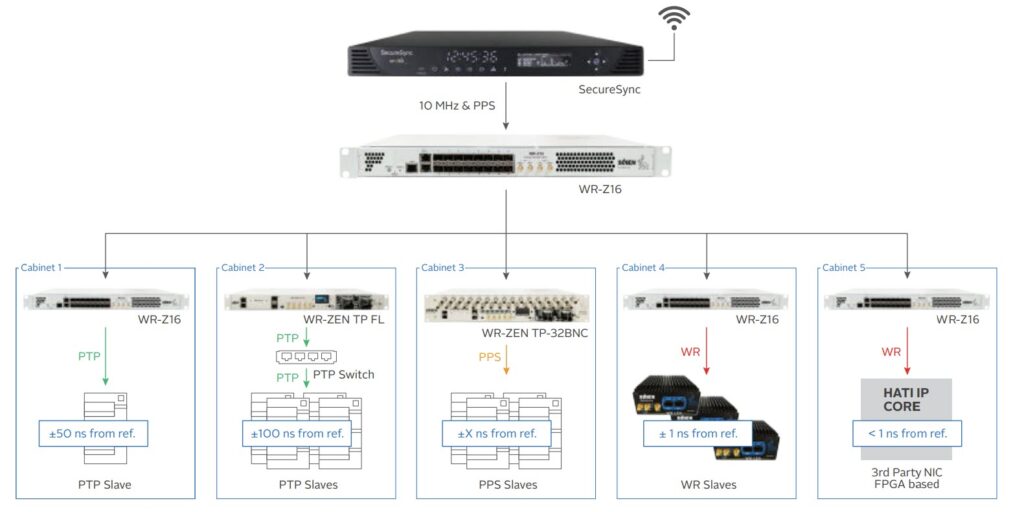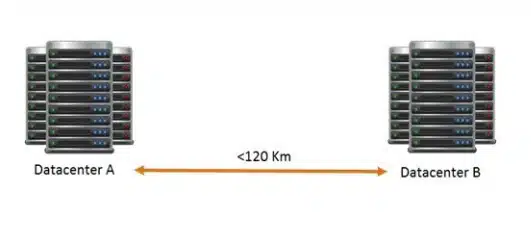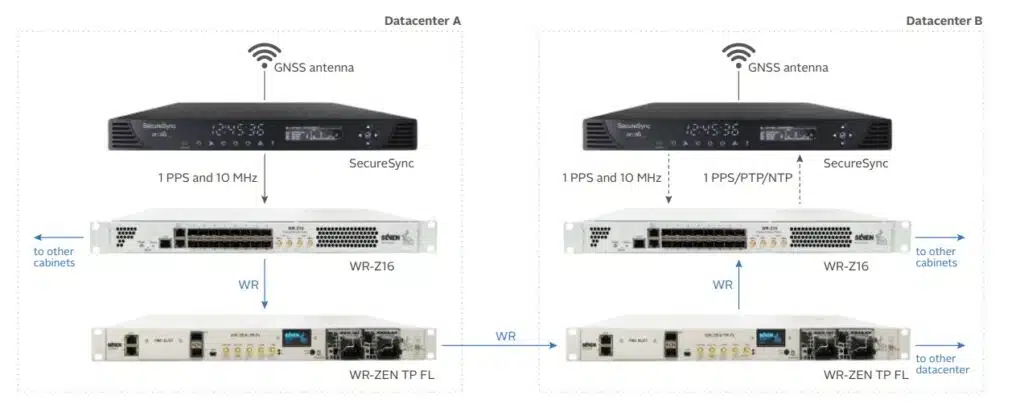Data Centers
Precise time synchronization is a critical requirement for system integrity and security inside data centers. Safran time servers, master clocks, and time distribution switches can help you can achieve sub-nanosecond accuracy and ensure your network stays synchronized with guaranteed uptime.
The Importance of Accurate Time in Data Centers
Accurate time and synchronization play a pivotal role in the success of data operators managing distributed systems. By ensuring precise time alignment across multiple nodes, data operators can unlock a multitude of benefits, including enhanced data integrity, streamlined data processing, improved analytics, and compliance adherence. When your data center infrastructure is synchronized with master clocks, IT administrators can confidently rely on consistent timestamps across nodes. This ensures events and data updates occur in the correct temporal order, mitigating conflicts and discrepancies. As a result, you maintain the integrity of datasets and trust the accuracy of the information processed.
Streamlined Data Processing and Analysis
By aligning timestamps, data operators can easily correlate and merge data from various sources, simplifying complex analytics and computations. This synchronization enables efficient data aggregation, event sequencing, and causal relationship establishment. With this, you can unlock valuable insights, perform accurate trend analysis, and make informed decisions based on reliable and coherent data.
Enhanced System Performance and Efficiency
Synchronized clocks enable optimized resource allocation, preventing conflicts and bottlenecks in distributed systems. Efficiently schedule tasks, manage concurrency, and avoid unnecessary delays or redundancies using synchronized timestamps. This ensures smooth and streamlined data flows, ultimately boosting overall system performance and maximizing resource utilization.
Compliance Adherence and Auditability
Synchronized timestamps facilitate the accurate sequencing of events and transactions, providing an auditable trail for regulatory compliance and internal audits. Timing and synchronization solutions demonstrate compliance with legal and industry standards.
Future-Proofing
and Scalability
Advanced technologies (Rubidium Holdover), protocols (NTP, PTP), and infrastructure support the evolving needs of data operators. Whether scaling up distributed systems or integrating new technologies, these solutions enable seamless expansion without sacrificing time synchronization accuracy. This ensures you can adapt to changing requirements and leverage emerging technologies without compromising on data integrity or system performance.
What Happens When Time Fails
Data Inconsistency and Integrity Issues
Unsynchronized clocks cause inconsistent timestamps and out-of-order events, leading to conflicting data updates and reduced system reliability.
Inefficient Data Replication and Recovery
Time gaps between nodes disrupt data replication, resulting in incomplete or outdated data and hampered recovery after failures.
Concurrency and Locking Issues
Poor synchronization causes nodes to misjudge event order, leading to race conditions, deadlocks, and potential data loss or corruption.
Inaccurate Event Ordering and Causal Relationships
Without accurate time, systems struggle to maintain correct event order, affecting distributed transactions and data consistency.
Compliance and Auditability Challenges
Lack of synchronized timestamps hinders the ability to prove event timing, risking non-compliance and legal issues.
Intra-Data Center Time Distribution
Safran delivers best-in-class synchronization technology inside data centers. The existing network infrastructures that have time synchronization protocols like NTP and PTP are vastly improved by using the White Rabbit protocol for time distribution. For intra-data center distribution, the solution is focused on distributing the resilient time reference provided by the Securesync. For minimum impact in the time error budget, Safran’s White Rabbit devices transfer the reference time to any point, any cabinet, with sub-nanosecond accuracy.
The delivery of timing to the end user’s equipment is provided with a wide range of available protocols (NTP, PTP, IRIG-B, ToD) as well as standard legacy timing signals like 10MHz and 1PPS. There is no need for link or cable calibration because White Rabbit is constantly measuring and accounting for the changes in the fiber optic link. White Rabbit is resistant to Packet Delay Variation (PDV) in environments with abrupt changes in traffic. It also allows users to work with redundant links and time references to provide a complete, resilient, PNT solution.

Because it has tested and proven interoperability with third party equipment, White Rabbit can be safely integrated into your current infrastructure, enhancing its timing performance. Capturing devices can use the PPS WR distribution. NICs and PTP-enabled switches can synchronize to WR devices using standard PTPv2.
Use Case
Sync Capturing Dev with PPS
Sync NICS with PTP a)
Sync NICS two PTP b)
Offset
<1ns
~50 ns
~100 ns
Synchronize Each Data Center Server With More Precision
Inter-Data Center Time Distribution
Time Distribution In A Metro Area
In a metro area, using the same time reference can be achieved by sending the clock reference over fiber from data center A to data center B. The only requirement is that the clock reference be in an area of around 100-150 Km wide, so they can be reached in a single hop. The end-to-end distance can be extended by using optical amplification or timing regeneration via intermediate WR nodes.

The solution includes an external time reference provided by the SecureSync and the White Rabbit network, which distributes this time reference over several data centers. Interoperability with third-party equipment has been already tested with satisfactory results at the end nodes (NICs, packet capturing devices, etc.). The resilience of the SecureSync combined with the failover mechanisms and holdover capabilities integrated in WR devices provides the ability to work in multi-source time references scenarios, resulting in a fully resilient PNT solution.
WR over Dedicated Fiber
The use of dedicated fiber greatly simplifies installation and first operation. With its exceptional advantages over PTP, White Rabbit helps users benefit from automatic, dynamic compensation of the asymmetry. This makes installation much easier by avoiding the need to calibrate the links. This scheme allows data centers to easily become sub-nanosecond synchronized. After that, users can distribute timing through the entire data center or extend it to a third.

WR Over Shared Fiber
Using shared fiber in DWDM systems is a much more cost-effective solution. The only disadvantage is that the automatic asymmetry compensation is not possible because the elements on the optical path can change between different infrastructures. This causes an unknown offset at the timing slave that must be compensated for. This handicap is overcome by using calibration methods. There are different methods, depending on feasibility, and they can be GNSS-assisted or stand-alone synchronization systems. After proper calibration, the high precision and stability of White Rabbit ensures sub-nanosecond accuracy in this kind of scenario.

Contact Us Today
To learn more about Safran data center time sync solutions.
